The world in a carton
Leaner and greener global supply chains
for fast-moving consumer goods

The products we use every day – from toothpaste, to tea, to tinned food – often reach our homes via extremely complicated global supply chains.
Toothpaste alone contains a wide variety of chemicals to clean, bind and flavour. These are derived in a lab from raw ingredients such as petroleum and plants, which are dug up or grown. The plastic tube is usually derived from oil, the packaging from trees. Toothpaste manufacturers then turn these into finished products and ship them around the world.
Vastly complex global supply chains began to take their current form in the late 80s, thanks to the rise of cheap reliable labour in newly open countries, trade agreements, and the rise of connected technologies.
One leading toothpaste manufacturer has 50 manufacturing and research facilities globally, and thousands of suppliers of raw and packing materials. Each factory must source ingredients which vary as consumer tastes and demands change. They must deliver the products to the shops that sell these products around the world. These criss-crossing supply chains exist for nearly every product on our supermarket shelves.
Vastly complex global supply chains began to take their current form in the late 80s, thanks to the rise of cheap reliable labour in newly open countries, trade agreements, and the rise of connected technologies.
But in recent years, this model had begun to shift. Growing environmental concerns are driving firms to reduce their reliance on unsustainable ingredients such as those derived from fossil fuels and reduce the carbon footprints created by global transportation. Rapidly changing consumer demands are shifting priorities from long-term certainty to agility. Meanwhile, new technology continues to present new opportunities improve efficiency and innovate.
These trends present threats and opportunities. Some involve harnessing incremental improvements, or making specific changes to products. Others may call for companies to rethink entire business models. In all areas, innovative thinking needs to be harnessed to take advantage of new opportunities, and to hedge against disruption from competitors and startups with greener or more personalised products.
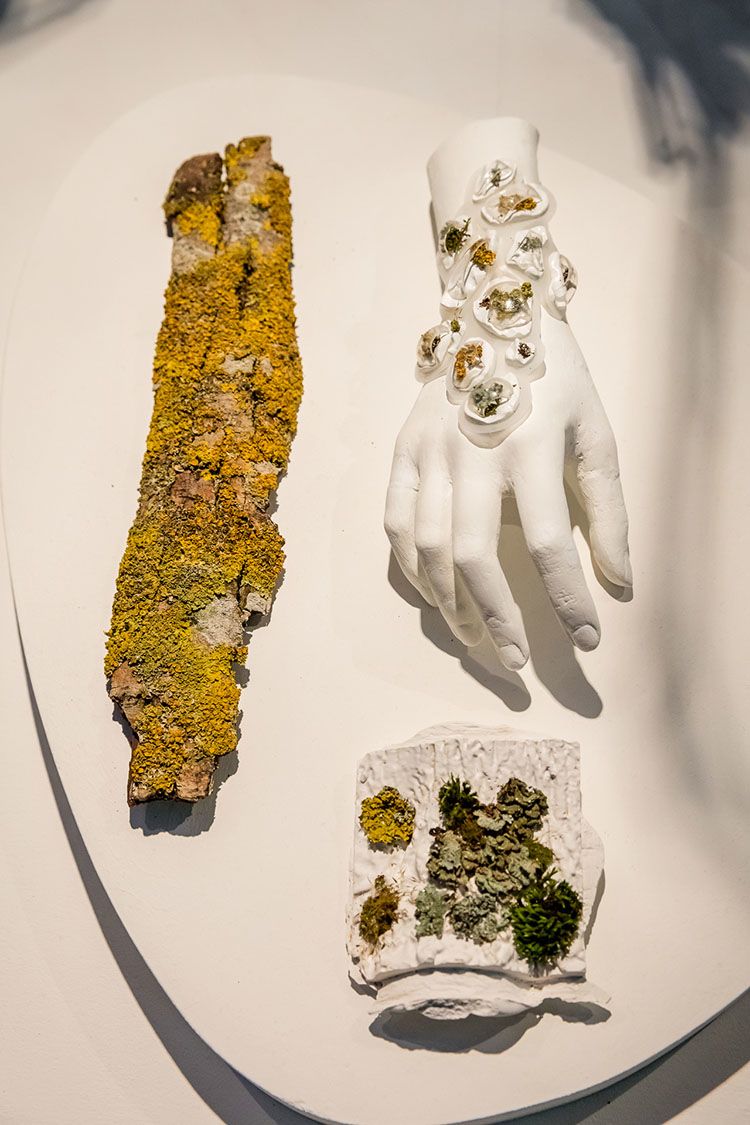
Imperial and the Royal College of Art offer two joint Master’s programmes in product design and innovation that address global challenges through design, engineering and entrepreneurial activities. Pictured here are exhibits from a 2020 work-in-progress show at the Dyson School of Design Engineering. Photos: Dan Weill
Imperial and the Royal College of Art offer two joint Master’s programmes in product design and innovation that address global challenges through design, engineering and entrepreneurial activities. Pictured here are exhibits from a 2020 work-in-progress show at the Dyson School of Design Engineering. Photos: Dan Weill
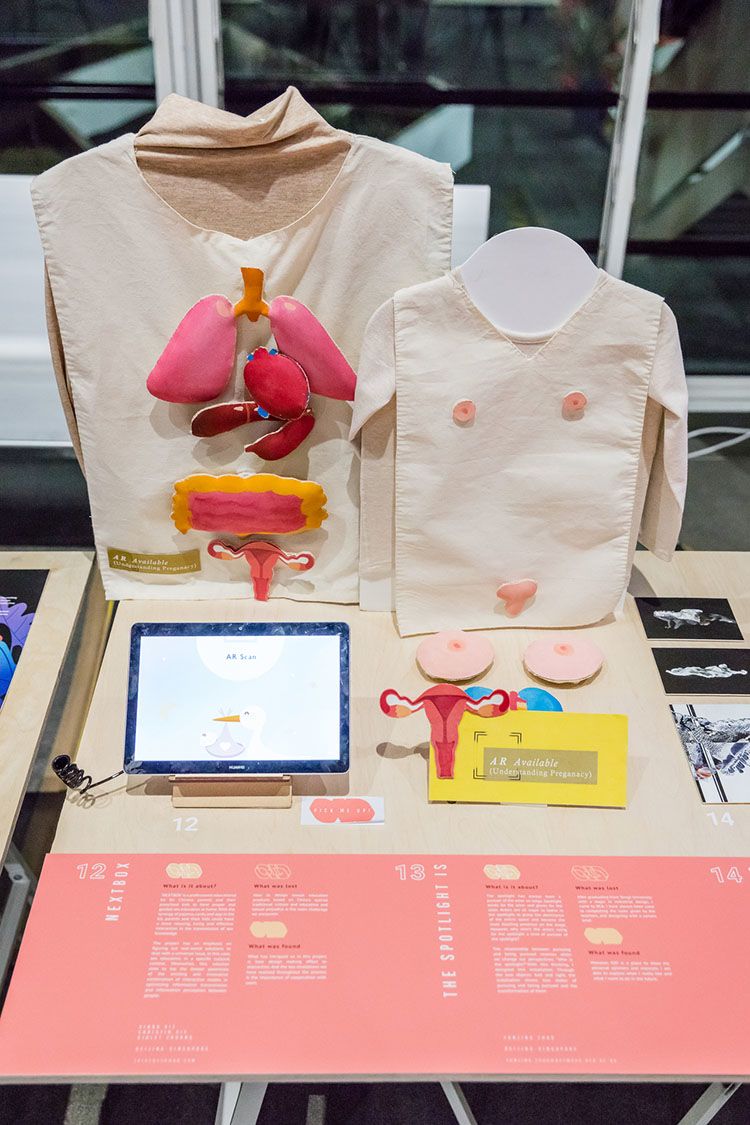
Imperial and the Royal College of Art offer two joint Master’s programmes in product design and innovation that address global challenges through design, engineering and entrepreneurial activities. Pictured here are exhibits from a 2020 work-in-progress show at the Dyson School of Design Engineering. Photos: Dan Weill
Imperial and the Royal College of Art offer two joint Master’s programmes in product design and innovation that address global challenges through design, engineering and entrepreneurial activities. Pictured here are exhibits from a 2020 work-in-progress show at the Dyson School of Design Engineering. Photos: Dan Weill
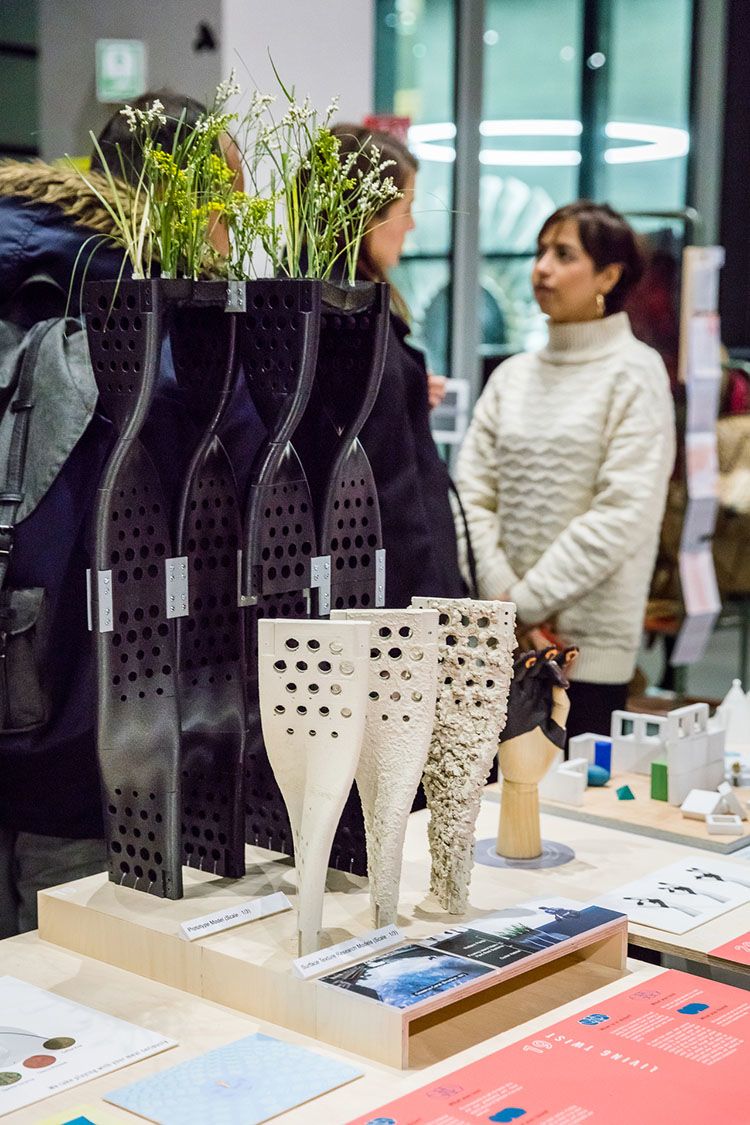
Imperial and the Royal College of Art offer two joint Master’s programmes in product design and innovation that address global challenges through design, engineering and entrepreneurial activities. Pictured here are exhibits from a 2020 work-in-progress show at the Dyson School of Design Engineering. Photos: Dan Weill
Imperial and the Royal College of Art offer two joint Master’s programmes in product design and innovation that address global challenges through design, engineering and entrepreneurial activities. Pictured here are exhibits from a 2020 work-in-progress show at the Dyson School of Design Engineering. Photos: Dan Weill
The impact of product development
The first step in considering how supply chains in fast-moving consumer goods (FMCG) need to change, is to look at what drives product development.
“Traditionally, FMCG innovation was done by a research team who came up with ideas, tested them, and settled on the best to take forward,” says Dr Stephen Green, Principal Teaching Fellow at Imperial’s Dyson School of Design Engineering. “But increasingly, companies are deploying design thinking – starting with the customer, a deeper understanding what they want and need, and designing products for them. That has implications right across the product development process and all the way down the supply chain”.
Dr Green points to a project, Open Food, as an example of how user need shapes products. The project brought together experts in design, manufacture, and computer science to explore how consumer habits could inform food and packaging design.
Participants prepared food using connected Internet of Things devices, such as spoons and scales, allowing researchers to study how they prepare common foods. This fed into new formulations for ready meals that better matched consumer desires and behaviour in terms of taste and ease of preparation.
Increasingly, companies are starting with a deeper understanding of what customers need, and designing products for them. That has implications right across the product development process and all the way down the supply chain.
Using technology to study behaviour is increasingly typical of how new products are developed. “You’ve got to think about how close we can get to the consumer these days,” says Dr Green. “It means you can move extremely quickly and be hyper-personalised. It allows you to steal a march on your competitors. But it also means doing things differently from a supply chain perspective.”
Long complex supply chains, and far away manufacturing facilities dedicated to optimally producing a single product, may not be best suited to this new world.
To illustrate, he points to project with an orange juice manufacturer. His team developed a way to capture a wide range of consumer reactions to the taste of different formulations. But the factory was carefully calibrated to produce a specific formulation and changing it took a long time.
The project sought to address this by developing algorithms that translate the consumer research findings into data that could be understood by manufacturing and supply chain ordering systems. This started moving the company towards a system where new research feeds into formulations, which then reshapes manufacturing and supply chains in more coordinated and agile way.
Design thinking shapes products, but new product decisions must also be connected to supply chains, to allow everyone to move quickly and get products to market as soon as the need has been identified. The faster trends change, the more important that the whole system is connected and agile enough to adjust – not just a series of distant silos.
Greener ingredients
One of the most significant consumer trends shaping FMCG is demand for greener products, from making makeup casings from biodegradable plastics, to reformulating cleaning products to use less water. Such changes in ingredients and formulations will also reshape supply chains
There is a huge appetite for product formulations using green bio-based molecules with the same functionality as existing fossil fuel-derived ones.
“Almost every FMCG company has made big environmental commitments. There is a huge appetite for product formulations using green bio-based molecules with the same functionality as existing fossil fuel-derived ones,” says Professor Nilay Shah OBE, Head of the Department of Chemical Engineering.
Imperial proactively researches new green chemicals that could be useful to industry and also works directly with companies to search for specific families of molecules they want to replace. A recent example saw researchers develop a surfactant that replaced a petroleum-derived precursor - used to create polystyrene, nylon, dyes and detergents - with one derived from wood or straw with similar performance characteristics.
Another major research focus is reformulating products to be greener. Imperial’s ground-breaking work into fundamental modelling of materials is helping FMCG companies redesign products with these new functionalities.
For example, a recent breakthrough in thermodynamic modelling by Professor George Jackson – the so-called statistical associating fluid theory – allows very precise predictions of the thermodynamic properties of complex fluid mixtures. This has been instrumental in understanding how to design more concentrated versions of products. This allows more product to be shipped per container, and so reduces total carbon emissions of shipping. The models have already been used by companies.
These changes in product design have important knock on effects down the line.
Recalibrating the supply chain
Changes to product formulation may call for new approaches to how the nodes of supply chains are distributed.
“If your input is straw instead of oil, that changes who you buy from and where you build factories,” says Professor Shah. “If you make more concentrated products, that improves the efficiency of transporting products. It’s all connected, and supply chains need to be recalibrated to deliver against these changes.”
This can be a complex calculus. If the source of the ingredients changes from an oil well in the Middle East to a field in Brazil, there may be value in moving your factory closer to the source, or closer to consumers, or somewhere in-between with cost-effective labour. And there is unlikely to be a single ingredient at stake – there are often multiple options for making a product, with varying chemical routes depending on availability of different ingredients.
There is a balance to be made between cost of labour, transportation, and infrastructure. The Imperial College Business School has done much work modelling these supply chain decisions, allowing comparisons of low cost vs local, manufacturing cost vs product miles.
One project explored how new products formulations would work under different supply chain scenarios in East Asia, evaluating three strategies ranging from highly centralised to very decentralised. The exact formulation, and how close you are to those ingredients impact total costs, so the optimum balance of formulation and supply chain management needed to be reached.
If the source of an ingredient changes from an oil well in the Middle East to a field in Brazil, there may be value in moving your factory. But there is unlikely to be a single ingredient at stake. Imperial has done much work to model these decisions.
Using sophisticated modelling techniques, researchers developed a framework to determine the optimal locations and capacities of plants, warehouses, and distribution centres. It looked at all relevant factors to minimise the total cost, including raw material, packaging, inventory, transportation, and depreciation.
In this case, the team showed that manufacturing the products at a centralised location, resulted in large economic supply chain benefits. This same modelling approach could be applied elsewhere, and may have different results depending on the variables. As products are reformulated and supply chains change, such modelling can help cut through this complexity to identify optimal location for facilities.

A wheat field in Brazil
A wheat field in Brazil
Deploying bioplastics
Widely available chemicals and materials offer lots of complex options in terms of how to structure supply chains. But FMCG companies also need to be on the lookout for wholly new innovations – which they can integrate into their supply chains – that can provide them with commercial advantages.
Imperial has always had a significant focus on supporting student to think innovatively and launch businesses. A number of academic and student startups are developing innovations that could benefit FMCG supply chains.
The Shellworks, one such startup, is developing bioplastics from waste products. CEO, Insiya Jafferjee, says: “We recognised there was a growing demand for biodegradable packaging from consumer goods companies who wanted to improve green credentials and meet customer demands.”
The company has developed a process to extract polymers from organic waste to create packaging for brands such as cosmetics, where customers are willing to pay more for more ethical products.
“In particular, we found that where people directly interact with products – such as foods or skin creams – they want organic, ethical ingredients. Many are let down by hard-to-recycle plastic packaging, and this is an area where brands can make a big improvement for conscientious customers by swapping in bioplastics.”
There are a growing number of biodegradable plastics, but many need specific conditions to biodegrade, such as industrial composting. End-of-life is not well implemented, undermining green claims.
So Ms Jafferjee and her co-founders - who combined background in materials and manufacturing, and who met on the Imperial and the Royal College of Art's Innovation Design Engineering programme - set up The Shellworks to address this.
The company has developed a process to extract polymers from organic waste to create packaging for brands such as cosmetics, where customers are willing to pay more for more ethical products. “We started with waste seafood thrown away by restaurants, but have gradually expanded to plant and other food waste.”
Flexibility is key to their offer. “A lot of companies spent a lot of time trying to create the perfect bioplastic,” says Ms Jafferjee. “We’ve taken a different approach, we work with companies to understand their challenge and design plastics suited to them, creating products that are needed.”
This offers FMCG companies more flexible options than off-the-shelf plastics. The biodegrading timeline is one example of an important variable – some FMCG plastic products will be used within a few weeks, others may need a shelf life of three years. The Shellworks have become adept at fine tuning their process to meet these different needs.
They are in conversations with a number of FMCG companies, and keen to hear from others.
The Shellworks is one of many Imperial startups in the FMCG space, which range from reuse and recycling, to intelligent product labelling and tracking. “It’s a very nurturing place for innovators” says Ms Jafferjee. “There is access to incredible range of expertise from professors and the Enterprise Lab gives huge amounts of support and resources, which creates a real diversity of ideas.”
The circular economy
So far, this feature has looked at supply chains as they are now – linear entities that take raw materials from the ground (or sea), process them, manufacture them, deliver them to store shelves, to customers, and finally into waste facilities.
But as sustainability rises up the agenda, supply chains are increasingly looking more circular, as products reaching end of life are reused or recycled back into the supply chain, replacing much of the need for virgin resources.
Dr Marco Aurisicchio, a Reader in the Dyson School of Design Engineering, is helping FMCG businesses redesign processes to harness the circular economy. This means rethinking the nature of supply chains, from how to capture products at end of life, convert them into useful materials, and feed them back into the supply chain.
“There are plenty of recyclable materials,” he says, “but this is rarely as good as it sounds.” Many products still end up in landfill, either because their parts cannot be easily separated (e.g. razors), a necessary step for current recycling facilities, or because people don’t put them in recycling bins in the first place. This is particularly problematic in countries without developed recycling infrastructure. Even when they are recycled, they are usually turned into lower value products rather that re-entering the same supply chain.
Dr Aurisicchio wants to help companies create a truly circular economy, where products are reused.
Waste prevention needs to be considered within product design and given equal importance to visual appeal and functionality. There needs to be a shift from just delighting customers, to also considering performance of product and resources across the lifecycle.
“Product design needs to think beyond the customer, to how to design economic, social and technical systems that source, transform and distribute materials in more sustainable ways,” he says. “This means considering the business case, the way people use products, and the technology to extract, manufacture and reclaim materials.”
He points to schemes like Loop, which in the UK partners with Tesco to deliver products in reusable packaging. Once they are used, the customer returns them, and Loop cleans them for reuse. “It’s not dissimilar to the way we once delivered milk,” he says.
Broadly, there are two such models. The Loop model uses ‘sequential reuse’ where the product container is constantly recirculated through shops and consumers.
The other is ‘exclusive reuse’, where the consumer buys and owns the container and refills it. Cleaning product manufacturer, Ecover, operates a scheme where users can refill their containers in supermarkets, while rival Splosh sends concentrated products direct to the consumer, who can mix it with water to refill their container.
These models need different thinking, says Dr Aurisicchio. “Waste prevention needs to be considered within product design and given equal importance to visual appeal and functionality. There needs to be a shift from just delighting customers, to also considering performance of product and resources across the lifecycle.”
That is a big change. Products will need to be designed to be easy to collect, reuse, recycle. Materials will likely shift from disposable plastics to durable steel or glass. The parts of supply chains that constantly source new virgin materials will ultimately need to be scaled down, and whole new systems developed to manage distribution, cleaning, and collection at a local level, usually involving collaboration with shops and delivery companies.
To support this, his team at Imperial are developing tools to help FMCG companies understand the opportunities to rethink product design.
One is the Flow Mapper tool. This easy-to-use tool, hosted in a virtual workspace, helps designers to map the lifecycle of a product, and explore where it falls out of circulation and what changes can be made to create a closed loop flow of resources.
It is designed to be a collaborative tool which brings together experts in engineering, design manufacturing, and recycling, to map out new approaches, then think through what such a product would look like.
“In large FMCG supply chains, no one owns the whole system,” concludes Dr Aurisicchio. The challenge is getting all stakeholders together and getting them to tackle the problem in a constructive way – this tool is designed to support that process in a way that is intuitive and collaborative”.
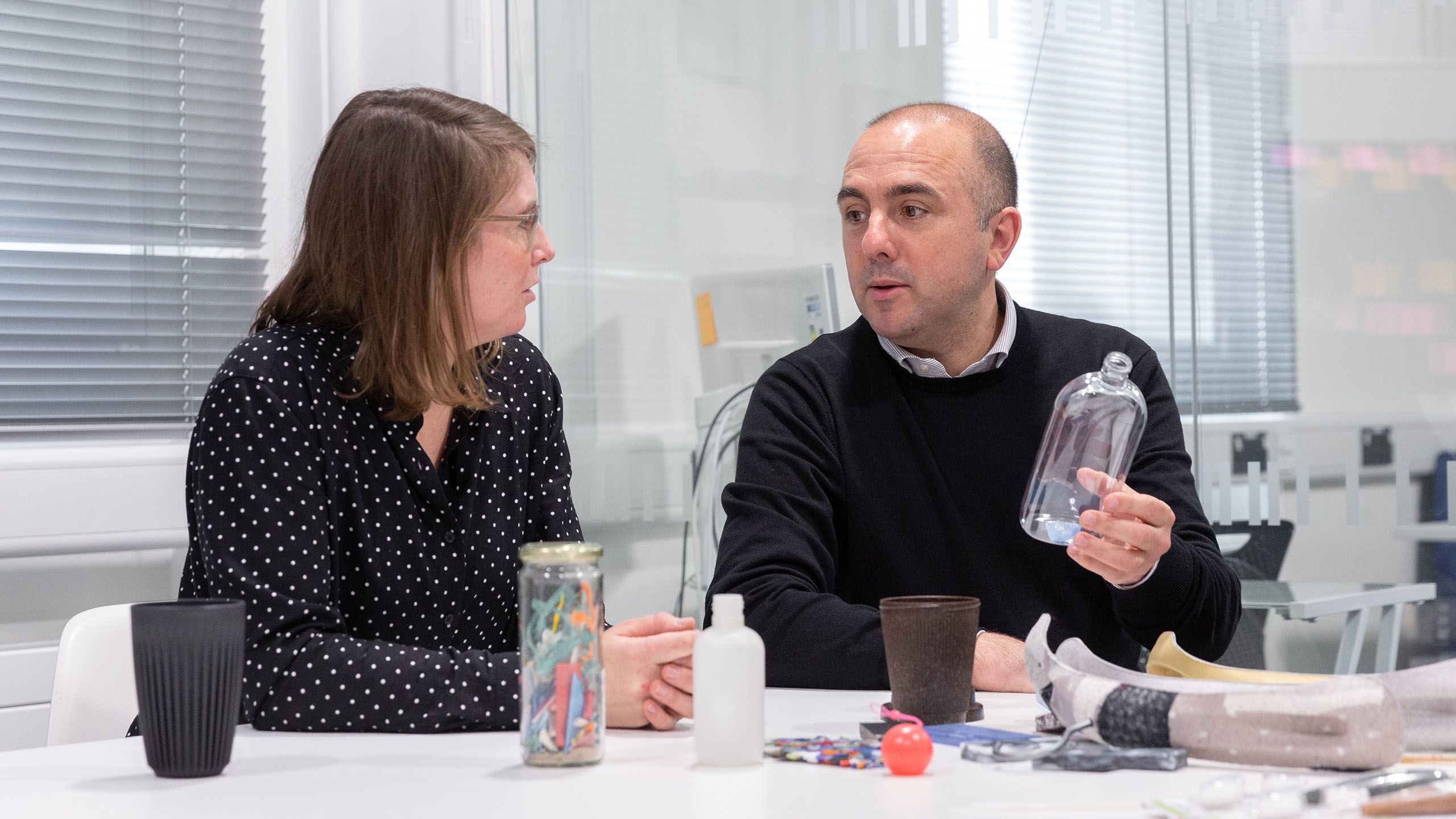
Dr Marco Aurisicchio in the Dyson School of Design Engineering (pictured right) is devising new ways to model resource flows in the circular economy. He is pictured here with PhD student Anouk Zeeuw Van Der Laan, who is working with him on this topic. Photo: Thomas Angus
Dr Marco Aurisicchio in the Dyson School of Design Engineering (pictured right) is devising new ways to model resource flows in the circular economy. He is pictured here with PhD student Anouk Zeeuw Van Der Laan, who is working with him on this topic. Photo: Thomas Angus
Automation and human decision-making
While locations and processes will change, products will still pass through factories, warehouses, transport, storerooms, and onto shelves. Those managing them will be looking to minimise disruption and optimise cost efficiency.
Many supply chain processes have become highly automated, and highly efficient. But automation can sometimes cause problems where it interacts with human decision-making. This may increase further as more uncertainty and faster change is introduced to supply chains.
Dr Jiankun Sun, Assistant Professor of Operations Management at the Imperial College Business School, has been looking at how interactions between humans and algorithms can lead to inefficiencies.
Dr Sun looked at an algorithm that recommended what box size to use. Warehouse workers deviated from the recommendation in over 5% of cases, mostly switching to a larger box.
When working with one industry partner, she noticed a curious problem. When algorithms recommended actions that seemed counter-intuitive to humans – even if they were right – the human would take a different decision.
In this case, she looked at an algorithm that recommended what box size warehouse workers should pack goods into. Initial research found that workers deviated from the recommendation in over 5% of cases, mostly switching to a larger box. This increased material cost, but more importantly it increased packing time as workers started packing one box, then abandoned it to find a bigger box.
This turned out to be a very common problem throughout many parts of the supply chains. When all these small delays are added up, they created significant costs. Dr Sun hypothesised that adjusting recommendations to account for human behaviour could improve efficiency.
She and her team developed a machine learning algorithm that learned when people were likely to deviate from the recommendation and choose a larger box. This was used alongside the original algorithm, so that when the chance of deviation is high, they were automatically directed to a slightly larger box. This reduced the rate of switching, and led to 4.5% faster packing times for targeted packages (those where the algorithm predicted a high chance of switching to larger box and considered changing the recommendation).
Having proved the point, this approach can now be generalised to a wide variety of other scenarios, from inventory ordering, to planning vehicle routes around warehouses, where humans interact with the algorithms and their decisions come into conflict with the algorithm’s recommendation.
Dr Sun concludes, “we need to pay attention to human deviations and understand the reasons for these deviations so that we can design algorithms better.”

Dr Jiankun Sun, Assistant Professor of Operations Management in the Imperial College Business School. Photo: Simon Jarrett
Dr Jiankun Sun, Assistant Professor of Operations Management in the Imperial College Business School. Photo: Simon Jarrett
Better contracts
Supply chains don’t just feed into FMCG companies' products, but stretch beyond them. Optimising relationships with the vendors who sell their products – such as supermarkets – is equally important.
Eddie Anderson, Professor of Analytics and Operations Management at Imperial Business School, has been looking at optimal approaches across supply chains.
“The nature of supply chains,” he says, “is that everyone in them is looking at ways to maximise their own profit in a competitive environment. But this often leads to an outcome that is sub-optimal for everyone.”
He uses game theory to look at contract structures that would allow retailers and suppliers to both do better. In particular, his work explores complex sales environments with multiple competing products from different suppliers, such as a supermarket.
In complex FMCG supply chains, there are so many components that it’s easy to focus on the value of each contract and lose sight of how they all interact. But in these complex environments, it turns out to be in everyone’s interest to structure contracts differently.
The conclusion of an upcoming paper is that, in many cases, the optimal contract model involves a fixed ‘franchise fee’ which the retailer pays to the supplier. This leads to products being purchased at a ‘cost plus’ price, where the retailer buys the products based on cost plus a fixed mark-up.
This is not a common structure. But Professor Anderson’s research suggests it works better than usual models, where there is an agreed price per unit with discounts for higher volumes.
Professor Anderson explains: “Take a supermarket. They have lots of different competing products. For each one they have to decide the optimal price point to maximise profit, balancing margin and sales volume. But each product’s pricing affects others. In some cases that is zero sum, for example, a toothpaste discount may redirect spending from one brand to another. In other cases a promotion – for example, of sun cream in summer - may lift a whole product category. Add to this, unpredictable events that affect buying habits, such as weather, competitor promotions, and we have a very complex network of decisions.”
“Now, imagine the retailer made all the brands they sell. This would allow them oversight of the entire supply chain and they could then set the ideal price point.”
The franchise approach Professor Anderson proposes allows them to recapture those same kinds of choices, since pricing follows real production cost, rather than wholesale price. While the reasons for this are complex, his work shows that this leads to marginal decisions being dealt with more efficiently.
“That maximises profit for both. The retailer can maximise margins, and the supplier makes money from the franchise fee, then everything else follows cost structures.”
In complex FMCG supply chains, there are so many components that it’s easy to focus on the value of each contract and lose sight of how they all interact. But in these complex environments, it turns out to be in everyone’s interest to structure contracts in this way. Professor Anderson is now keen to help FMCG companies use these findings to improve their contract decisions.
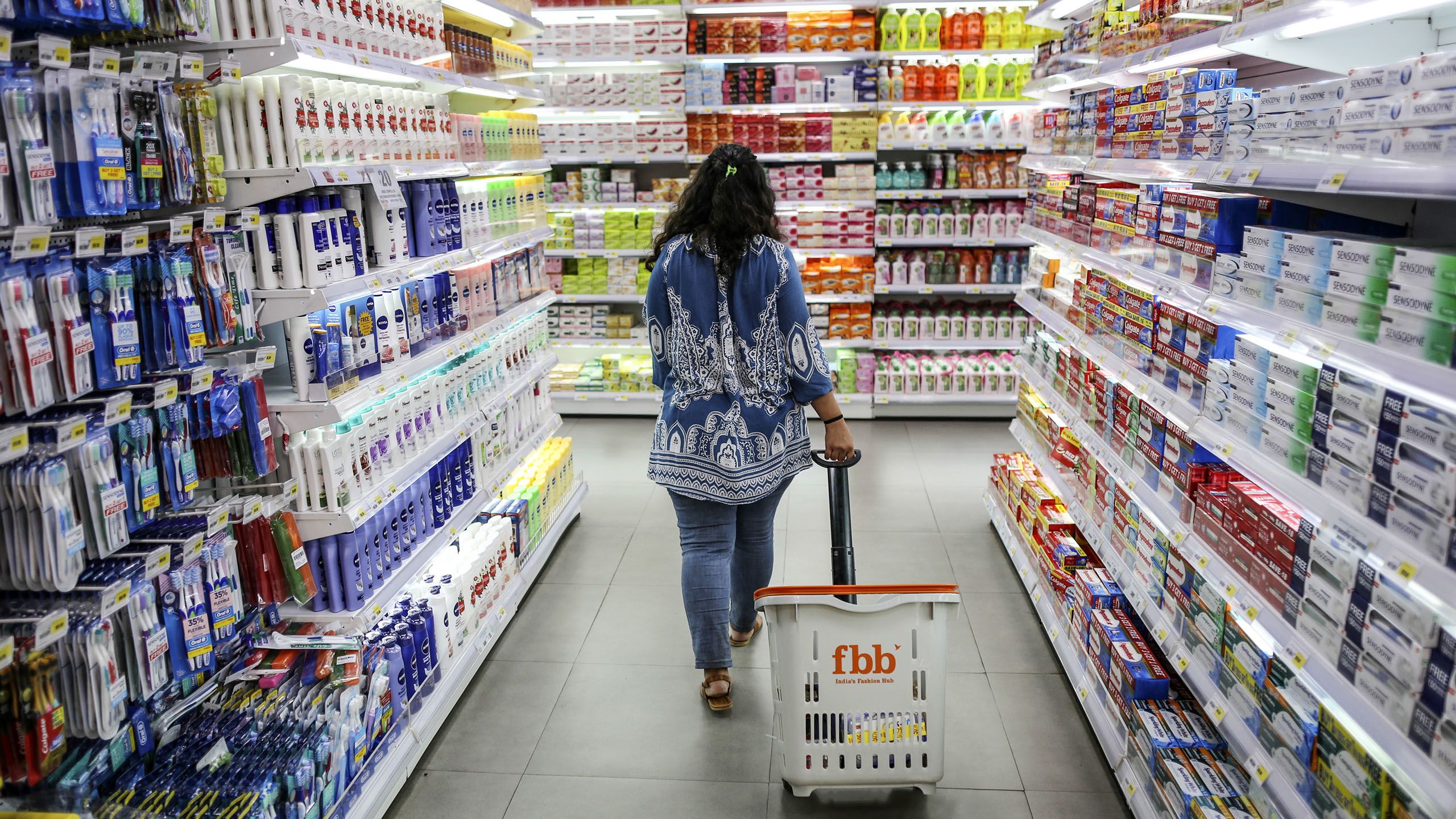
A shopper walks through an aisle displaying personal care goods at a Big Bazaar hypermarket, operated by Future Retail Ltd., in Mumbai, India. Photo: Dhiraj Singh/Bloomberg via Getty Images
A shopper walks through an aisle displaying personal care goods at a Big Bazaar hypermarket, operated by Future Retail Ltd., in Mumbai, India. Photo: Dhiraj Singh/Bloomberg via Getty Images
An opportunity
FMCG supply chains are hugely complex, and made more so by the many changes driving them to be smarter and greener. Change can come from small technological advances, through to movements which reshape the very nature of how supply chains work.
Professor Shah concludes: “Companies entrenched in old, rigid models may struggle. But those ready to embrace the new opportunities presented by science and technology, and driven by more ethical and demanding consumer, have much to be excited about.”
Imperial carries out world-leading research with applications to FMCG supply chains, and supports many leading companies.
This feature was commissioned for the Imperial Business Partners (IBP) programme, part of Imperial's Enterprise Division. IBP provides curated access to the best of Imperial’s expertise, technologies and startups and give members practical, actionable insights to help shape the future of their businesses.
Video: Imperial for business
